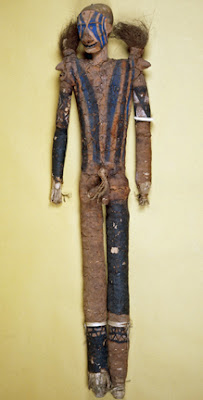|
The British Museum describes this as a 5 feet tall god figure from Vanuatu.
It is an effigy of a deceased individual, made of a human skull, cane, clay, fibre, and a boar’s tusk armlet. © Trustees of the British Museum
It turned out they were donated by Fred Skeffington of 72 Victoria Road, Kilburn on 16 March 1895. Born in 1860 in Blaston, Leicestershire, his father Reuben Skeffington was a grazier with 255 acres, employing four men. Reuben prospered and twenty years later was working 1,050 acres and employing 18 men, 2 women and 4 boys.
Fred Skeffington became a ship broker’s clerk in London and in 1888 he married Anne Caroline Harriet Rivolta in Woolwich. She was the middle class daughter of John Septimo Rivolta, a City wine merchant who lived at 25 Priory Road. He was also involved in various Buenos Ayres companies.
In 1891 Fred and Anne were living in south London at 12 Bromley Road, Lee. They had a daughter, Amy Anita, who was born on 2 November 1891 but she was not baptised until 1906. By 1895 when Fred sent the collection to the British Museum, they had moved to 72 Victoria Road, Kilburn and in 1898 they were renting 21 Plympton Road, near Dyne Road. For some reason they kept moving house – and after a typically short stay they were at 15 Victoria Mansions, Grange Road, Willesden Green, (1902 to 1903). In 1905 they were at 140 Wymering Mansions, Wymering Road near Kilburn Park Road and Paddington Recreation Ground. A year later when they baptised their 15 year old daughter Amy, they were living at 66 Bloomfield Road, Maida Vale.
A ceremonial spear or paddle.
© Trustees of the British Museum
Ceremonial dance mask or chief’s head dress.
Fred Skeffington allowed the British Museum to photograph the mask and the ceremonial spear and then asked for them to be returned to him. As far as we know the human effegy is still in the BM collection. © Trustees of the British Museum
In the 1911 census, 19 year old Amy Skeffington was a stenographer for a mercantile company and was living with her uncle, Arthur Skeffington and his family in Blackheath. Her mother Ann had died earlier that year, and sadly Fred was an inmate at the Royal Hospital for Incurables, West Hill, Putney. He was one of the 45 male and 183 female patients. Now the Royal Hospital for Neuro-disabilty, this large hospital for the mentally ill was set up by philanthropist Andrew Reed in 1854. Fred Skeffington died there in 1912.
His daughter Amy married twice; firstly to Robert Macmaster in 1915 and then to Gordon Tabernacle in 1948. She died in St Marylebone in 1969.
Although it has proved possible to work out who Fred was, we don’t know how he got these rare tribal pieces. After all, he wasn’t an intrepid Victorian explorer who travelled to the South Pacific. Perhaps he obtained them from his work as a shipbroker’s clerk?
|





Leave a Reply
Want to join the discussion?Feel free to contribute!